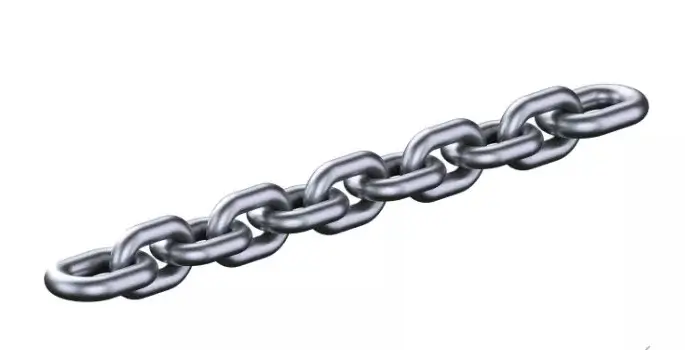Different types of chains are actively used in agriculture, cargo transportation, industrial and construction sites. Such products can move and hold very heavy objects and structures. In situations where high loads are involved, it is almost impossible to find an alternative to chains.
Chain strength classes
The products we are interested in differ in material, design, link size and other characteristics. An important parameter is the strength of the chain, which depends on the indicators of the breaking and permissible (usually called working) loads.
The breaking load is understood as the minimum load under which the process of chain destruction begins. The working load is the greatest load that the chain can withstand during operation.
Both indicators depend on the chain manufacturing technology used in the production of raw materials and the cross section of the bar. The reliability index of a product is determined by its strength class. The latter varies between 2–12:
high-strength lifting chains have a class of at least 8;
Normal chains (general purpose, traction and cargo) are designated by numbers 2–7.
With the same cross-section of links, chains of a higher class are always more the load capacity of products of lower strength. Important point! A high-strength chain has a lower mass compared to products of normal strength.
Varieties of chains
Chains are made of a steel bar. Its section determines the caliber of the finished product, often called the diameter. The larger this indicator, the higher the load the chain will withstand.
The step is understood as the length (internal) of one chain link. The ratio of caliber and pitch determines the type of load-lifting product, which can be:
short-link; ">
long-link.
The ratio of the pitch and diameter of short-link chain products is less than 3.5. They are recommended for use on winches, cranes, other traction and lifting devices and mechanisms. Such chains rarely tangle during operation, withstand severe loads. Their strength class is higher than that of long-link products.
Chains with a pitch to diameter ratio of 3.5 or more are classified as long-link. They weigh less than short-link products, have lower strength. But chains with long links are more mobile and flexible. It is not recommended to use them for work under shock loads, with heavy loads.
Chains are divided into calibrated and non-calibrated, depending on the level of accuracy of their production. In the manufacture of the former, GOSTs and certain technical conditions are strictly adhered to.
Calibrated high-strength lifting chains are characterized by step accuracy and other indicators. They are used in critical lifting and traction mechanisms.
Normal strength chains
These products have a breaking load in the range of 240–800 N/sq. mm. Such load chains with strength class from 2 to 8 are used on various hoisting and transport mechanisms and machines, on land and water transport for fixing, moving, suspension, tying heavy loads. In Russia, they are produced according to the State Standard 2319.
High-strength lifting chains
Their tensile strength at breaking load is at least 800 N/sq. mm. High-strength round-link chains are made of high-alloy steel bars with a cross section of 0.4–2 cm. They are necessarily hardened at high temperatures. Each link is calibrated to ensure dimensional and shape accuracy. The calibrated high-strength chain of the eighth, tenth strength class due to the hardening procedure receives high resistance to strong, constant friction and the negative effects of abrasive materials, fatigue operational strength, load capacity.
Round link chain of strength class 8–12 is produced according to standards 25996 (products for equipment used in mining) and 30188. Such products have the following advantages:
maintainability - individual segments and links of the product can be replaced new;
operated in a wide temperature range - from -20 to +350 degrees and more;
resistance to aggressive external influences;
increased flexibility.
Chain strength class 8-12 is a guarantee of long and trouble-free service of lifting products for several years in the most difficult operating conditions.
Chains of strength class 8
Load chain Strength class 8 is intended for use as part of lifting mechanisms with manual and electric drives, transport, traction and various lifting equipment. Long link chains of 8 strength class are also used




